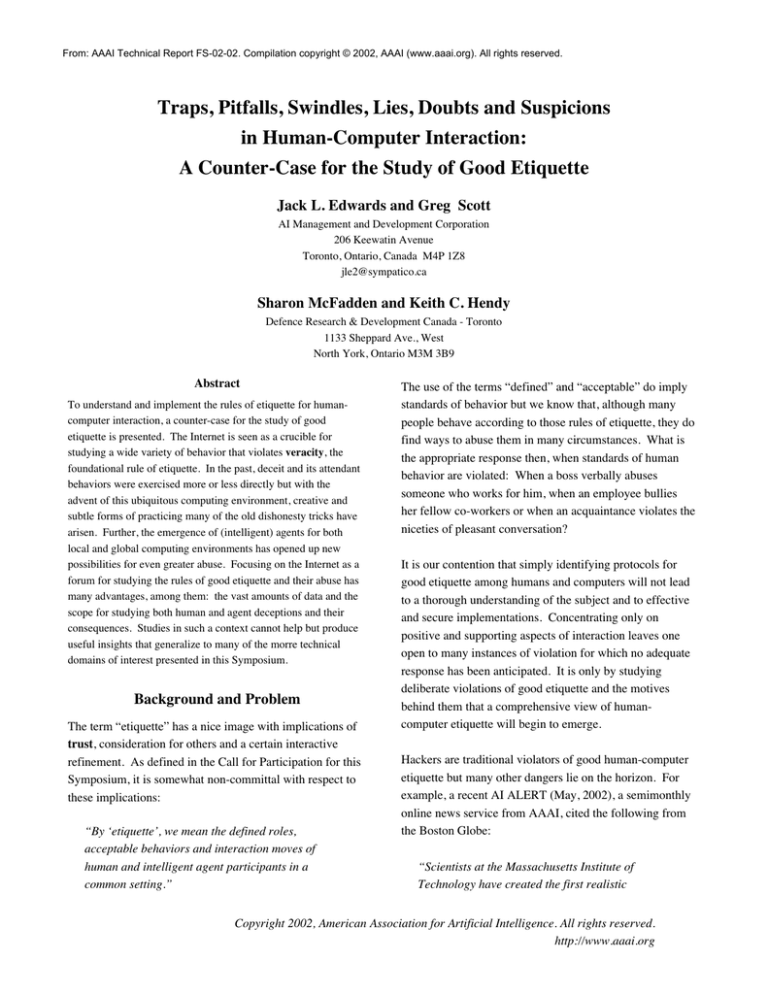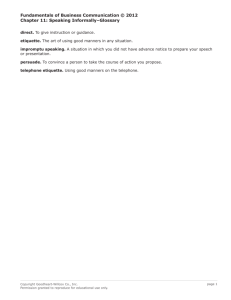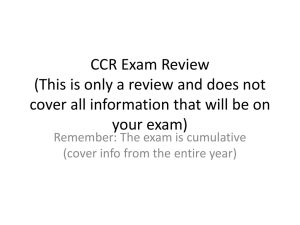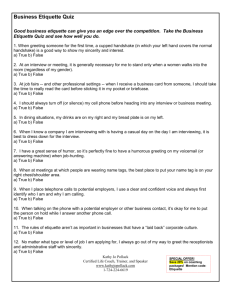
From: AAAI Technical Report FS-02-02. Compilation copyright © 2002, AAAI (www.aaai.org). All rights reserved.
Traps, Pitfalls, Swindles, Lies, Doubts and Suspicions
in Human-Computer Interaction:
A Counter-Case for the Study of Good Etiquette
Jack L. Edwards and Greg Scott
AI Management and Development Corporation
206 Keewatin Avenue
Toronto, Ontario, Canada M4P 1Z8
jle2@sympatico.ca
Sharon McFadden and Keith C. Hendy
Defence Research & Development Canada - Toronto
1133 Sheppard Ave., West
North York, Ontario M3M 3B9
Abstract
To understand and implement the rules of etiquette for humancomputer interaction, a counter-case for the study of good
etiquette is presented. The Internet is seen as a crucible for
studying a wide variety of behavior that violates veracity, the
foundational rule of etiquette. In the past, deceit and its attendant
behaviors were exercised more or less directly but with the
advent of this ubiquitous computing environment, creative and
subtle forms of practicing many of the old dishonesty tricks have
arisen. Further, the emergence of (intelligent) agents for both
local and global computing environments has opened up new
possibilities for even greater abuse. Focusing on the Internet as a
forum for studying the rules of good etiquette and their abuse has
many advantages, among them: the vast amounts of data and the
scope for studying both human and agent deceptions and their
consequences. Studies in such a context cannot help but produce
useful insights that generalize to many of the morre technical
domains of interest presented in this Symposium.
Background and Problem
The term “etiquette” has a nice image with implications of
trust, consideration for others and a certain interactive
refinement. As defined in the Call for Participation for this
Symposium, it is somewhat non-committal with respect to
these implications:
“By ‘etiquette’, we mean the defined roles,
acceptable behaviors and interaction moves of
human and intelligent agent participants in a
common setting.”
The use of the terms “defined” and “acceptable” do imply
standards of behavior but we know that, although many
people behave according to those rules of etiquette, they do
find ways to abuse them in many circumstances. What is
the appropriate response then, when standards of human
behavior are violated: When a boss verbally abuses
someone who works for him, when an employee bullies
her fellow co-workers or when an acquaintance violates the
niceties of pleasant conversation?
It is our contention that simply identifying protocols for
good etiquette among humans and computers will not lead
to a thorough understanding of the subject and to effective
and secure implementations. Concentrating only on
positive and supporting aspects of interaction leaves one
open to many instances of violation for which no adequate
response has been anticipated. It is only by studying
deliberate violations of good etiquette and the motives
behind them that a comprehensive view of humancomputer etiquette will begin to emerge.
Hackers are traditional violators of good human-computer
etiquette but many other dangers lie on the horizon. For
example, a recent AI ALERT (May, 2002), a semimonthly
online news service from AAAI, cited the following from
the Boston Globe:
“Scientists at the Massachusetts Institute of
Technology have created the first realistic
Copyright 2002, American Association for Artificial Intelligence. All rights reserved.
http://www.aaai.org
videos of people saying things they never said a scientific leap that raises unsettling questions
about falsifying the moving image. In one
demonstration, the researchers taped a woman
speaking into a camera, and then reprocessed
the footage into a new video that showed her
speaking entirely new sentences, and even
mouthing words to a song in Japanese, a
language she does not speak. The results were
enough to fool viewers consistently, the
researchers report. ... But scientists warn the
technology will also provide a powerful new
tool for fraud and propaganda - and will
eventually cast doubt on everything from video
surveillance to presidential addresses. ...
Previous work has focused on creating a virtual
model of a person's mouth, then using a
computer to render digital images of it as it
moves. But the new software relies on an
ingenious application of artificial intelligence
to teach a machine what a person looks like
when talking.”
The last part of our definition of etiquette refers to
“participants in a common setting.” The most ubiquitous
common setting today is the Internet where many
communications, whether they get through or not, can be
sorted into one or more of the terms in the title of this
presentation. Examining those types of communication and
associated examples will prove useful but, before
proceeding to that, a vision is needed for how studying
etiquette on the Internet might justify such an examination.
The Internet as the
Major Communication Medium
of the Foreseeable Future
Why will the Internet be the future of most human-agenthuman interaction? There are several rather obvious
answers to that question. First, some part of almost
everyone’s work and leisure time now extends beyond
local processing. They may be communicating via a local
area network, a wide area network or an Intranet but some
portion of their work and often their leisure activity (in
some cases the majority) will involve the Internet. The
fact that vast amounts of both work and leisure time are
spent on the Internet, with the consequent vulnerabilities
for individual and corporate resources, means that there are
more than a few confidence men, tricksters, vandals and
even terrorists willing to violate good communication
etiquette or, more accurately, to use aspects of good
etiquette for malicious, dishonest and destructive dealings.
Second, there has been a trend toward increasing
involvement of technology in exchanges that were
formerly person-to-person. Consider the following simple
example: Ten years ago if a person wanted to get a
message to someone in a hurry, he would most likely have
picked up the telephone and placed a call. Today, that
same task is very often accomplished by sending email.
Both approaches involve human-human interaction where
machines, along with their more recently adaptive
software, serve as the communication medium. As
technology continues to advance, the medium will evolve
with future human-computer-human interaction mediated
by ever more intelligent agents.
Even now, with the proliferation of spam, people are
resorting to the use of junk-mail filters, which delete
messages sent anonymously or not addressed explicitly to
the recipient. Such filters can block messages from an
entire domain if considerable spam is found to come from
a single source. Another use of simple agents involves the
use of auto-responders to send replies to emails received
while a person is away.
A recent Apple newsletter (August 8, 2002) described the
new Mac OS X mail software that uses “adaptive latent
semantic analysis” to learn what the user considers to be
spam and what is legitimate mail.
Like the weather, everyone complains about
junk mail. But we’ve actually done something
about it.
We’ve made Mail smart. It learns. Thanks to
sophisticated mail filtering technology adaptive latent semantic analysis, to be
exact—Mac OS X Mail learns what you
consider to be junk email. And after an initial
training period, you can tell Mail what to do
with your junk email.
So instead of sending email directly to you, I may be
sending it to an autonomous piece of software (an agent)
that represents your interests and which decides whether or
not to pass that email on to you. The very primitive email
agents in these examples will (in the years to come) almost
certainly evolve into much more complex filtering agents
with the ability to learn what the user considers to be junk
mail, what isn’t, whether to pass email to a user or discard
it, whether to forward select email to a private address
when the user is away or hold it for later review, and so on.
Third, examining the kinds of agent currently being
proposed and developed, it is clear that many need to be
Internet-based in order to function effectively. Indirect
attacks on the integrity of systems through their supporting
agents (including their security agents) thus become
distinct possibilities.
Finally, traps, pitfalls, swindles, and the like appear to
generalize easily to the Internet and ultimately to
intelligent agents that travel its pathways.
Adaptation of classic fraud schemes already have brought
many of them into the Internet age. Ponzi schemes (see
Smithsonian, 1998), such as pyramid scams and chain
letters, have moved from paper to fax and now to computer
screens, thereby dramatically increasing their potential for
widespread distribution and attendant profit.
It is a certainty that in future intelligent agents will be
created that will learn which of many fraudulent techniques
work best, with whom, where and under what
circumstances. Such agents likely will be refined and
targeted to segmented portions of the population (“Mark”
categories, if you will) and so, studying the old schemes
will give insights into what the future holds and how best
to counter intelligent, yet fraudulent agents.
The exploits of Limehouse Chappie, Kangaroo John,
Yellow Kid Weil and other confidence men of the last
century (Maurer, 1940) are nothing compared to those
making a much wider presence felt on the Internet.
Ubiquitous computing is giving rise to ubiquitous
confidence games, some with deadly consequences.
More recent material for comparison with the older con
artists can be found on and off the Internet, which deals
with everything from confidence tricks to hacking by
(intelligent) agents to terrorist attacks. A wealth of
material exists but two instructive examples are Zeltser
(2000), who identifies a number of malicious agents and
describes both their common and unique characteristics,
and Blackhat.com (2002), an organization devoted to
promoting understanding among professionals about the
security risks to their computers and information
infrastructures.
Veracity:
The Foundational Rule of Etiquette
Much of the speculation about human-computer etiquette
is predicated on a fundamental rule of truthfulness (“Be
honest”), and that notion is so fundamental that it often
gets only a brief mention before the writer moves on to
“more interesting” topics.
Yet so much of human-human interaction violates that
assumption that we need to explore in some depth how
dishonesty and deceit are making their way into that
increasingly common setting for communication, the
Internet.
Trust appears throughout the papers in this Symposium
and is grounded in a belief that the other fellow is
fundamentally honest. Considerable discussion and
research has been directed to the topic of trust (see
Castelfranchi, Falcone, Firozabadi and Tan, 2000a&b),
how it is developed, lost and rebuilt. What is rarely
studied in the same context are the wide range of
techniques for deliberately deceiving, undermining and
defrauding others and how the tension of the contradictory
concepts can best be understood.
It is instructive that many of the rules of etiquette can serve
both good and bad motives. Scam artists may develop
considerable skill in conforming to most of the other rules
of etiquette in the service of their fraudulent activity.
Imagine yourself to be a scam artist or worse, a terrorist,
and think for a moment how you might use the following
rules of etiquette to further your sinister motives:
•
•
•
•
Be helpful
Be relevant
Be brief
Be pleasant
•
•
•
•
Be respectful
Be prompt
Protect privacy
Provide options
Now imagine a fraudulent or terrorist software agent with
an effective range of communication skills for
communicating with humans and other software agents and
ask yourself the same question.
Much of the detailed “Netiquette” rules (e.g., Shea, 1994;
RFC 1855, 1994), somewhat more popular in the 1990s,
and provided as guides to govern chat rooms, emails,
newsgroups, mailing lists and the like, can be
accommodated easily by the con artist in the service of
both his principal goal to deceive and refinements on that
clandestine motive such as: “the mark must not even
know when he has been taken.”
A Counter-Case for the
Study of Good Etiquette
Given an arguably strong justification for examining the
Internet as the future of most human-agent-human and
agent-agent communication, and veracity as the
foundational rule of etiquette, we are now in a better
position to examine the categories of deceit pointed to in
the title of this paper and through which a counter-case for
the study of good etiquette can be made.
Traps – Although a physical manifestation, we do not
mean “golf bunkers” or devices for preventing the passage
of water. We do mean “a device for capturing or detecting
a person unawares.”
Browsers with implemented cookies (simple agents) are
just such mechanisms and are made even more effective by
web sites that prevent access unless the user accepts their
cookies, a trap one cannot avoid if the user wants the
reward of access.
Shortly before 911, a widely circulated Internet myth was
that of a supposed study that examined the IQ’s of US
Presidents back to FDR. The description of the study
included the name of the Research Institute, the names of
supposed world-renown research scientists who had
conducted the study and a rather professional recounting of
the results, with Bill Clinton at the top of the list with an
IQ of 182 and George W. Bush at the bottom with an IQ of
91. This kind of trap fosters myths that people want to
believe and a professor friend of mine, who had sent me a
report of the study, upon finding out it was bogus, gave
one the best description for having fallen into this kind of
trap, saying he had been “eagerly gullible.”
That trap even appeared as a topic in a Garry Trudeau
Doonesbury Cartoon (1 September 2001)
Pitfalls – “unsuspected dangers or difficulties.” There are
many dangers and difficulties in our interactions with other
humans that may be transferred to machines. Certainly,
viruses are dangers that may be unexpectedly lurking in
email and their attachments. Luckily, there is McAfee™,
Norton’s AntiVirus™ and Personal Firewall™ to help
make sure that most such traps are never sprung.
Swindles – “cheats, scams or frauds perpetrated on a
person.” A recent comment in the online publication,
“Internet Scambusters” (Scambusters, 2002a), reads:
“In 2001, 5.2% of online consumers fell victim to credit
card fraud, according to a recent survey by GartnerG2.
Online merchants lost a staggering $700 million to fraud in
2001 - over 1% of total annual online sales. Online fraud
losses were 19 times as high as offline fraud, according to
the study.”
Lies – “statements known by the originator to be untrue.”
Although not having the status of a virus, some messages
have some of the same effects. Masquerading as good
Samaritans, they warn of viruses associated with particular
files and suggest that we remove them immediately. In
doing so, however, we realize too late that we have deleted
a system or application file, which then prevents the
system from booting or the application from running. The
insidious nature of this type of lie is that it often enlists
well-meaning people who act as unwitting agents for the
originator by sending copies of those messages to their
friends.
Doubts – “feelings of uncertainty or disbelief.”
This is the beginning of the collapse of trust, a key
element in support of that fundamental rule of good
etiquette: truthfulness and honest dealings. Something in a
message may produce feelings of unease and uncertainty.
We may not have any clear idea of the source or nature of
that unease but may decide that we don’t want to read
some message or download some attachment, and so we
delete it. Unfortunately, we may delete messages that not
only are legitimate but also are important to our work.
Suspicions – “partial or unconfirmed beliefs, often about
some negative aspect of a person, event, situation, etc.”
After repeated doubts, increased suspicions about a set of
communications can lead to a complete collapse of trust.
A key concern of Internet retailers is that people will come
to distrust “anyone they do not know” on the Internet and
will no longer use the medium to buy legitimately
manufactured and marketed goods. The more traps,
pitfalls and swindles we are exposed to, the more likely
this state of affairs will prevail. The statistics on swindles,
cited above, provide considerable cause for their concern.
As is evident in the cited examples above, many contain
aspects that permit classifications into more than one
category in this paper title. A swindle or fraud may also
involve a trap, like that in the “Nigerian Advance Fee
Scam” (or, “4-1-9 Fraud”). The swindle lures people with
the promise of millions, once “hooked” has them come to
Nigeria or a border country for a final meeting, tells the
person that they do not need a visa, pays off customs
officials to let them into the country, springs the trap by
telling them they are there illegally and then “bleeds” them
of much of their savings with the promise to get them out
of the country and avoid prosecution.
Here are a couple of paragraphs from an example of this
swindle, which was recently sent to one of the authors of
this paper:
“I wish to inform you that we have FORTY-SIX
MILLION US DOLLARS ($46Million), which accrued
from deliberate inflated contracts awarded by the Federal
Ministry of Petroleum Resources from my Corporation,
Nigerian National Petroleum Corporation (NNPC) during
the past military regimes and executed by a consortium of
multinational companies in the Oil Industry…
“Consequently, we humbly request your gracious
assistance towards the transfer of the above stated sum into
a personal off-shore account to be nominated by you…We
agree to offer you 20% of the total amount involved for
your assistance while 5% will be mapped out to cover
expenses made in course of the transfer.”
In June of 1995, an American was murdered in Lagos,
Nigeria, while pursuing this scam, and several other
foreign nationals have been reported as missing.
Recently, Perreaux (August, 2002), writing in one of
Canada’s two national dailies, reported on a business man
who was roped into this scam and who, several years later,
still gives the impression that he believes it to be genuine:
Paul Blazev admits he has thrown away
$500,000. He has lost his life savings, his
marriage and his tile business. He is in trouble
with Revenue Canada. Still over coffee in a
Calgary hotel, he dials his cell phone and sends
off another $2,500. (p. A3)
When the author recently broadcast information on this
scam, the following email was received from an
acquaintance:
“I must admit that I got sucked into the scam several
months ago and kept a whole file on it. The scam email
was also attached to the message that I received and it was
the very same one that I was involved with just a different
name.
“I even called a number in Nigeria and some cell phone in
Spain to arrange a meeting with this fellow. The call tipped
me off as the fellow I talked with was very unprofessional.
I then did some research online and found out about the
scam.”
Exploring these categories and examples is meant to
illustrate the point that a thorough understanding of
etiquette is not possible without an active consideration of
the many ways in which its fundamental rule can be
violated and its other rules enlisted in the service of
deception and fraud.
Active consideration promotes a deeper understanding than
incidental reflection which often occurs when treating only
the positive aspects of a subject. In active contemplation
of deceit, fraud and the like, the mind is engaged to
construct creative and wide-ranging violations that force
broader consideration of issues like (personal) protection
and security. Also, considering only positive aspects of
etiquette, allows continued assumptions of benevolence to
bias the character of the study.
A good example of how this works was illustrated years
ago by Norman and Rumelhart (1975) who asked people to
look at a building and describe what they saw, probed them
until they no longer had anything else to say about the
building and then asked them to imagine they were theives
and re-describe the building. Subjects had no problem
adding substantially to their descriptions.
Ensuring Good Etiquette in
Human-Computer Interaction
Security precautions are the principal response to system
abusers, whether they are applied over the Internet or some
other system, and whether the abusers are human or
software agents.
Security is predicated on the notion that there are people
and things that you cannot trust and whose motives, if
successfully realized, could have detrimental effects on the
goals you are trying to achieve.
How then can we be sure that veracity, that foundational
rule of etiquette, is maintained in our communications,
and, as technology becomes ever more sophisticated, that it
will continue to be maintained?
As local (standalone computers; TVs; LANs) and global
(Internet; Intranets; WANs) systems evolve, software
applications will assume greater roles in ensuring veracity
and will take over much of what we do now and many
things we likely could never do.
Many software applications already are in the process of
evolving into intelligent agents that will serve entire
communities of users. It can be seen that security and
maintenance software such as Norton Utilities™,
AntiVirus™ and Personal Firewall™ are evolving in that
direction.
Related components are being collected into single
packages, such as Norton System Works™ and the Internet
Security™ packages from Symantec. Live Update™ is
what might be called a second-generation, industrialstrength agent now included in those packages. It provides
automatic updating of virus definitions, patches and other
useful elements and sits on your computer to serve your
security and maintenance needs on a daily basis.
Windows XP provides automatic and periodic updating of
the operating system and other Microsoft files on your
computer and often it is unclear what the nature of those
updates include. Such updating unquestionably is useful
but other software “vendors” who may offer free software
could incorporate similar updating agents that would not be
as benevolent as the ones just described.
Secure systems are both defensive and offensive and the
above examples are a little bit of both, relying on active
agents to update a variety of systems with passive
measures, such as new virus definitions that protect against
unwanted attacks.
Security also has considerable scope of meaning. In
addition to a protection against intruders that could
undermine task competency and system integrity, it
generalizes to issues of commonly held knowledge and
values.
In the ubiquitous environment of the Internet, information
groups such as Scambusters (2002b) actively broadcast
warnings about new frauds and swindles as a means of
helping to protect consumers. Sites like ConsumerSentinel
(2002) provide more passive information allowing users to
visit the site and check on prize promotions, work-at-home
schemes, telemarketing scams, identity theft and other con
games. Urban legends sites such as Snopes (2002),
Hoaxbusters (2002) and the like provide users with a way
to check out the veracity of the information they receive in
communications from friends, acquaintances and strangers.
The proliferation of pornography on the Internet is an
unwanted intrusion to many, especially as it makes its way
into classrooms and homes where children surf the Net.
For several years now, governments and private
institutions have grappled with how to control information
that violates the ethics and values of society, while
maintaining sufficient freedom of expression. The US
Congress passed the Children's Internet Protection Act in
2000, which forces schools and libraries to use Internet
filtering software or lose federal dollars. That law has
repeatedly met with objections from private organizations
and has been declared unconstitutional in its present state
on two occasions by the courts (CIPA, 2002). To date, no
satisfactory solution to the problem has been found. Some
recent information on CIPA appears on the NTIA (2002)
site.
An intriguing question is how to incorporate into an
intelligent agent what these sites do to support factual truth
and protect societal values. Of course, the effort is already
underway through filtering agents that control access to
unwanted and potentially harmful sites and through
automated alerts about scams and hoaxes, but future work
could examine how those functions could be combined into
a personal agent and what proactive measures that agent
might take against repeat offenders.
These last two areas raise interesting possibilities for the
future of agent technology. Disagreements over the
truthfulness of shared “knowledge” and the desirability of
certain social values could set the stage for what can be
termed “agent wars,” where some agents seek to
disseminate information that other agents have been
created to prevent. Added functionality could provide
agents with the ability to misrepresent themselves or to
hack other agents in an attempt to prevent them from
achieving competing goals. The technology that emerges
from those “agent wars” will have implications for other,
possibly more serious matters of security.
Veracity Agents
Given that the central concern of this paper is with
veracity as the foundational rule of etiquette, a natural
consequence is the development of one or more agents
whose job it is to ensure that the communications a user
receives are tested for their truthfulness.
A number of questions present themselves: What
communications should be tested? What kinds of tests are
possible? What are the contingencies of response? What
are the vulnerabilities of other agents working on behalf of
a user? What role would a veracity agent have in helping
to maintain the integrity of those other agents? How will
such an agent maintain its own integrity?
The last three questions imply the possibility of what might
be called second-order traps, pitfalls and swindles. They
address software agent-to-agent contact and response, with
exchange of information occurring in the background of
human communications, and out of sight of human users.
Example violations of good agent-to-agent etiquette would
include the misrepresentation by an agent of its identity,
the masking of its purpose, falsification of the information
it is seeking and evasiveness about the information it was
programmed to provide. Such deceitful behavior could
occur in the presence of filtering agents responsible for
protecting personal or corporate information and
consequently lead to the loss of that information and other
valuable assets.
Larry Fonner at MIT has described this as an “arms race of
sorts,” a race between good-intentioned agents who must
co-exist with their “evil-intentioned” counterparts, which
seek to spy on users for underhanded and nefarious
purposes (Hamilton, 1999)
In the presentation for this Symposium, more detailed
ideas and work on the design and creation of veracity
agents will be presented and discussed.
Project Status
Testbed work described in this report is being conducted
by Artificial Intelligence Management and Development
Corporation, as an internal research and development
project, and is in its early stages. Implications for a wide
variety of security concerns make the project interesting to
a number of public and private-sector organizations. Work
on veracity agents has begun with discussions centering on
design and range of focus. Prototype work is underway.
References
Norman, D.A., & Rumelhart, D.E. (1975). Explorations In
cognition. W H Freeman & Co.: San Francisco.
NTIA (2002). Request for Comment on the Effectiveness
of Internet Protection Measures and Safety Policies by
the National Telecommunications and Information
Administration.
http://www.ntia.doc.gov/
ntiahome/frnotices/ 2002/cipa_52202.htm.
Perreaux, L. (August 21, 2002). They will never see a
penny: Alleged Nigerian Fraud. National Post, p. A3.
RFC1855
(1994).
Netiquette
http://www.dtcc.edu/cs/rfc1855.html
Guidelines
Scambusters (2002a) Newsletter #50, 14 May 2002.
Scambusters (2002b) http://www.scambusters.org/
Shea, V. (1994).
Francisco.
Netiquette.
Albion Books: San
Smithsonian (December, 1998). In Ponzi We Tru$t.
Smithsonian magazine.
http://www.smithsonianmag.si.edu/smithsonian/issues98
/dec98/ponzi.html
AI ALERT (May, 2002). At MIT, they can put words in
our mouths. (reported from The Boston Globe.) A
semimonthly online service from the American
Association for Artificial Intelligence.
Snopes (2002). http://www.snopes2.com/
Apple (August 8, 2002). Coming Attractions: Mail. Apple
eNews.
Zeltser, L. (2000). The evolution of malicious agents.
http://www.zeltser.com/agents/agents.html
Blackhat.com (2002). http://www.blackhat.com
Castelfranchi, C., Falcone, R., Firozabadi, B.S., & Tan, HY. (Eds.) (2000a). Special issue on “trust in agents.”
Part 1. Applied Artificial Intelligence, 14(8). Taylor &
Francis: London, UK.
Castelfranchi, C., Falcone, R., Firozabadi, B.S., & Tan, HY. (Eds.) (2000b). Special issue on “trust in agents.”
Part 2. Applied Artificial Intelligence, 14(9). Taylor &
Francis: London, UK.
CIPA (2002). For a copy of the Children's Internet
Protection Act passed by the US Congress, see
http://www.ifea.net/cipa.html
ConsumerSentinel
sentinel/
(2002)
http://www.consumer.gov/
Hamilton, T. (September, 1999). Task masters. Globe and
Mail report on business: technology. Canada.
Hoaxbusters (2002). http://hoaxbusters.ciac.org/
Maurer, D. W. (1940). The big con. Anchor Books: New
York, NY.





